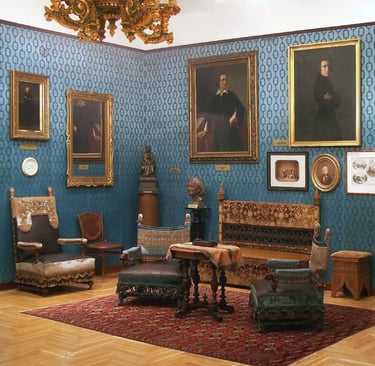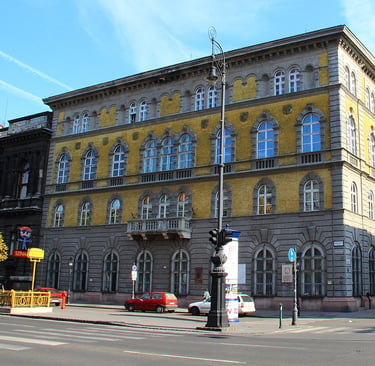Ferenc Liszt Memorial Museum
Where echoes of a musical genius linger in the silence of a grand piano


A Shrine to Sound: The Spirit of Liszt in Budapest
Tucked into a dignified corner of Budapest, where the neo-Renaissance architecture still sighs with the breath of the Austro-Hungarian Empire, lies the Ferenc Liszt Memorial Museum. It is more than a museum—it is a sanctum of inspiration, a refuge for those who seek to understand not just the music of Liszt, but the temperament, ambition, and spiritual fervor that shaped one of the most transformative figures in Western music.
This modest yet profound institution is nestled within the former home of the composer himself. The building forms part of the old Academy of Music, where Liszt lived and worked during the final years of his life. Walking into the museum is like stepping through a veil of time: here, silence is sacred, and every corner seems to hum with the faint aftertones of a sonata, a nocturne, a Hungarian rhapsody half-remembered by the walls.
Liszt the Man, the Myth, the Mystic
Ferenc Liszt (1811–1886) was not merely a composer and pianist. He was a lightning storm dressed in velvet. His fame during the 19th century was colossal—women reportedly swooned at his concerts, and his hands, so gifted with divine agility, were worshipped as relics. Yet beneath the glittering career of the virtuoso, there was a soul in restless search of transcendence. A devout Catholic, a philanthropist, a traveler, and a musical revolutionary, Liszt spent his final years in Budapest, weaving the final strands of his immense creative tapestry.
The museum doesn’t just memorialize him—it reflects him. In every object, every manuscript, every scuff on the original floors, there’s a sense of Liszt’s complexity. He was a man who waltzed through the courts of Europe yet ended his life in monastic simplicity, a man of dazzling technique who wrote music of aching restraint and introspection. This place is not just for musicologists and pianists—it’s for anyone curious about the human capacity for creation.
A Journey Through the Museum
Upon entering, visitors find themselves in Liszt’s study and salon, preserved with meticulous care. These rooms are more than reconstructions—they are immersive realities. The Bösendorfer piano, his most beloved, still stands in its corner like a loyal companion waiting for his hands. The furniture, the walls, the curtains—they have all been chosen or preserved in harmony with the aesthetic of Liszt’s time and taste.
One particularly moving object is Liszt’s death mask—intimate and solemn, it reminds visitors of the fleeting nature of earthly fame. And yet, nearby, the manuscripts speak of immortality. The ink may have dried, but the compositions it carries live on in symphonies, in sonatas, in film scores and elevator music alike. In these rooms, the mortal and the eternal brush shoulders.
The museum also holds personal relics: his baton, his glasses, his letters. There’s a deeply human connection in seeing Liszt’s spectacles—fragile, aged, and utterly ordinary. It is a glimpse into the vulnerability of a man so often depicted as a demigod of sound.
The Liszt Legacy in Education
It is no accident that this memorial is within the same building that once housed the Royal Academy of Music. Liszt did not only compose; he also taught, guided, and shaped generations of musicians. His students included many who would go on to shape European music themselves. The museum pays tribute to this educational mission through its connection to the present-day Liszt Academy, one of the most prestigious conservatories in Europe.
This institutional continuity isn’t just symbolic—it’s real. Students pass through the same corridors where Liszt once pondered harmony and counterpoint. They learn not just from textbooks but from the ghosts of those who came before. The museum often hosts concerts, lectures, and masterclasses, acting as a bridge between past genius and future brilliance.
Hungarian Soul, Universal Genius
While Liszt spent much of his life abroad—in Paris, Weimar, and Rome—his heart beat in time with his homeland. He infused Hungarian folk rhythms into the classical tradition, reworking them into something dazzling and new. His Hungarian Rhapsodies remain among the most beloved and technically challenging pieces in the piano repertoire, celebrating not only the gypsy music he admired but also the restless spirit of a people on the edge of Europe.
The museum makes it clear: Liszt was a cultural ambassador for Hungary long before soft diplomacy had a name. His face has appeared on Hungarian banknotes; his name graces institutions, streets, and airports. And yet, in this small museum, all the national honors dissolve into something purer: a quiet reverence for a man whose music still unsettles, uplifts, and transcends.
A Composer’s Mind on Display
For those inclined toward analysis, the collection of original manuscripts is a treasure trove. Liszt was not a casual composer—his drafts reveal a mind constantly revising, refining, reaching. One can trace the evolution of a piece across pages, like watching the growth of an organism. There is something oddly moving about seeing where he paused, scratched out, and rewrote.
The museum also includes facsimiles and annotated versions of some of his most famous works, offering a glimpse into his compositional thinking. These aren’t just exhibits—they are dialogues across time, between the composer and the visitor.
Architecture and Atmosphere
The building itself adds to the enchantment. With its polished wood panels, high ceilings, and generous windows, it breathes with quiet dignity. The museum has resisted the lure of hypermodern renovations, preferring authenticity over spectacle. The lighting is gentle. The flow of rooms respects the visitor’s contemplation. In an age of sensory overload, this is a space that trusts silence, pauses, and slow wonder.


Liszt’s Faith and Final Years
A lesser-known but deeply important aspect of Liszt’s life is his spiritual transformation. Later in life, he took minor orders in the Catholic Church, earning the title of Abbé Liszt. While he never renounced his musical career, he sought a quieter path, turning increasingly to religious music and introspection. The museum honors this turning point with a selection of sacred compositions, religious texts, and symbols of his ecclesiastical life.
It’s in these later works—his masses, oratorios, and short devotional pieces—that we meet Liszt the penitent, the seeker, the philosopher. Gone is the dazzling showman; what remains is a man approaching the eternal with humility. It’s a side of Liszt often overlooked in the popular imagination, and yet, within these museum walls, it finds space to resonate.
Live Concerts in a Living Museum
One of the most enchanting features of the Ferenc Liszt Memorial Museum is its ongoing concert series. Unlike many traditional museums, this one remains vibrantly alive with music. Visitors can hear Liszt’s pieces played on his own instruments, in the very rooms where they were conceived. These performances are not just entertainments—they are acts of preservation, a way to keep Liszt’s spirit dynamically engaged with the present.
Pianists from around the world consider it a special honor to perform here, and audiences are often left speechless, touched by a performance not only of skill but of profound historical intimacy. To sit in that salon, surrounded by the composer’s own belongings, while hearing his music performed live, is to experience time collapse into a single, transcendent moment.
From Budapest to the World
Though the museum is rooted firmly in Budapest, its influence extends globally. Through its partnerships, digital archives, traveling exhibitions, and online presence, it serves as a cultural ambassador for Hungarian music. Visitors from around the world leave with a new appreciation for the depth and breadth of Liszt’s contributions—not only to piano music but to orchestration, harmony, programmatic form, and musical nationalism.
This role is even more vital in an age when classical music struggles to retain its place in everyday culture. The museum fights this erosion not with fanfare, but with integrity, authenticity, and grace.


Visiting Information
Address:
Ferenc Liszt Memorial Museum
1064 Budapest, Vörösmarty utca 35.
(Housed in the Liszt Academy building)
Opening Hours:
Tuesday to Saturday: 10:00 AM – 5:00 PM
Closed on Sundays, Mondays, and public holidays.
Admission:
Standard tickets, student discounts, and senior concessions are available. Group visits and guided tours can be arranged in advance.
Concerts:
Chamber concerts and solo recitals are held regularly. Tickets are available on-site or through the official website. Some performances may be streamed online.
Accessibility:
The museum is accessible to visitors with mobility difficulties. Audio guides are available in multiple languages.
Getting There:
The museum is easily reachable via the Budapest Metro (Line 1 to Vörösmarty utca). It’s within walking distance of Andrássy Avenue and the Liszt Ferenc Square.
Nearby Attractions:
Combine your visit with a tour of the Liszt Academy’s main concert hall, stroll through the historic Jewish Quarter, or enjoy a coffee in the artistic cafés of the Terézváros district.
Official Website and Social Media
For updated information about exhibitions, concerts, educational programs, and visiting hours, consult the official website:
Website: https://lfze.hu/ferenc-liszt-memorial-museum
Facebook: https://www.facebook.com/lisztferencmemorialmuseum
Instagram: https://www.instagram.com/lisztferencmemorialmuseum
YouTube: https://www.youtube.com/@LisztMuseum








